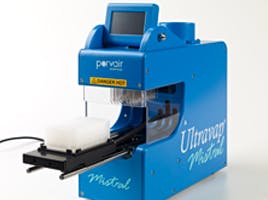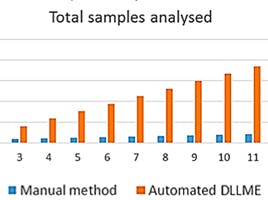
26 Oct 2021
Solid Phase Micro-Extraction (SPME)
By Philip Aston
“Garbage In – Garbage Out” is something we trainers at Crawford say a lot during our training courses, whether it is for method development, statistical analysis or troubleshooting instrumentation. The quality of a method and the results we obtain from it are directly related to the ability to sample the analyte and deliver it to the chromatographic system. If we can remove interferences, the identification and or quantification process will be easier and this is the same if we can deliver an appropriate amount for the system to analyse, so sample delivery systems play an very important role in modern labs.
Laboratories today have a wealth of techniques to choose from to improve their methods in order to meet either regulatory or customer requirements. Cleaning a sample prior to analysis to remove interferences and/or enrich the analyte can be done using liquid-liquid extraction (LLE) or solid-phase extraction (SPE) and these can be “fine-tuned” by selecting the appropriate solvents, sorbents and method details. LLE can require large volumes of solvent and is labour intensive if sample throughput is a goal of the lab. SPE is also time consuming but we have a large array of possible sorbents to choose from which allows method developers to be very selective in what is retained or not retained.
GC sample delivery comes in many flavours with the most common being the liquid injection into a split/split-less inlet. The inlet will vaporise the entire sample and rapidly deliver it onto the column but this has it’s downsides. Once such is that the entire sample is delivered to the column, solvent included, which will be in a greater excess of the sample and can cause issues with early eluting peaks and damage columns. Samples are rarely contain just a single analyte, so everything in the matrix will also be delivered into the inlet which will build up and require more frequent maintenance and can also generate many more peaks in a chromatogram.
Alternative techniques are used to either improve selectivity or sensitivity. Headspace delivery is one such technique and this has the added selectivity of only sampling the analytes which are sufficiently volatile to leave the solvent and enter the headspace. This can be further improved with dynamic headspace systems but these techniques take more time that standard injections and usually require complex method development to ensure precision. Figure 1 illustrates several different sample extraction types that can be employed to clean up the sample either before or during delivery to the GC system.

Figure 1 - Performance comparison of common GC sampling techniques (Chromacademy)
Solid Phase Micro-Extraction (SPME) is a simple adsorption/desorption technique that uses a fibre coated in an adsorbent material to extract analytes from liquid matrices or headspace gas. The sample is pierced by the needle and the SPME fibre is then exposed to the sample which allows analytes to adsorb to it. (Figure 2 from Chromacademy)
The fibre is then retracted, the needle moves to the GC inlet and exposes the fibre again to allow the retained analytes to be desorbed and delivered to the column (Figure 3 from Chromacademy).
Why SPME
SPME combines the advantages of analyte sampling, isolation, and enrichment into a single process. Selectivity is obtained by the fibre coating whilst the thickness of the coating adjusts for molecular weight and volatility.
- Fibres can be used for multiple samples (50-100+ times)
- Non-destructive to samples
- Solvent-free which reduces costs, lab risk and waste.
- Easy to automate (Gerstal autosamplers can perform simple SPME analysis and also carry out advancements such as Multi-Fibre Exchange (MFX) and on-fibre derivatisation.
- Can be used on solids, liquids or gases and almost any matrix.
- Samples can be taken in the field and analysed in the lab.
- Lower limits of detection due to reduction in noise and analyte enhancement.
For ensuring consistent and quantifiable results from samples, other factors to consider when optimising the extraction are:
- Agitation which can increase the chances of interaction with the fibre to improve sensitivity or reduce sampling time.
- Incubation temperature and time to promote the transfer of the analyte to the vapour state
- Optimization of the extraction time to allow the equilibrium to have been reached
- Liquid extraction for semi-volatile analytes that do not transfer to the vapour state as easily and also for at-source sampling
- Headspace extraction for volatile analytes is improved with the added selectivity of the fibre
- Changing the pH-value of the sample to promote the transfer to the vapour state for analytes or suppress it for interferences
SPME Fibres
When choosing a suitable SPME fibre, similar considerations are used as for selecting GC columns in that the chemistry and the dimensions are important.
To select the correct fibre we consider the following:
- Polarity
- Molecular Weight
- Concentration
- Matrix Complexity
Polarity allows us to use another of our favourite sayings from training, “LIKE DISSOLVES LIKE” which means the polarity of the fibre should match that of the target analyte, such as non-polar phases for non-polar analytes, so we match the inter-molecular attractions to encourage the equilibrium of the analyte out of the sample and into the fibre.
There are two types of SPME coatings:
- Particles embedded in polymeric films for adsorption of analytes where extraction is by physically trapping/interaction with analyte. These have high surface area porous particles and the analyte faces competition for sites so therefore these have limited capacity.

PDMS is the same material used in DB-1 columns and is a non-polar column because the methyl groups will interact with samples via Van der Waals interactions where as PEG will interact with analytes via dipole interactions and/or hydrogen bonding, polar bonds.
- Polymeric films for absorption of analytes where extraction is by partitioning into liquid phase. There is no competition for sites so there is a much high capacity.

The absorbent type fibres include PDMS as the binder and contain porous particles such as, Carboxen, divinylbenzene (DVB) or a combination of both.
Absorption is a more efficient extraction technique so is suited to applications where sensitivity is a key parameter but they are limited in their linear range. Samples at higher loadings or applications with a varying level or concentration or matrix can find adsorption fibres more flexible.
To determine the dimensions of the fibre, we consider the molecular weight as it is related to the hydrodynamic volume and the volatility as both of these factors will determine the ability of the analyte to be able to interact with the fibre. Larger molecules will take longer to reach equilibrium but will also be harder to remove so will increase the amount being sampled whereas smaller molecules will be able to move through the pores more freely and will not be retained on the fibre. Smaller, volatile compounds will need a thicker film to “slow them down”.
Tips and Tricks
Here are some ways to ensure your SPME analysis runs smoothly from our colleagues at Anatune.
- The sample should be as homogenous as possible.
- Ensure the correct vial septa are used (screw cap blue/white or SPME crimp cap). It is very important not to “over crimp” the vials so that the septa are distorted to protect the injection needle.
- Do not overtighten the GC septum nut, if the septum is overtightened it will core and leak.
- Use a narrow bore (approx. 0.8 - 1mm ID) SPME liner in the injection port for high linear velocity and faster desorption in splitless mode. If you wish to split it is advisable to use a 2mm ID liner for normal split characteristics because it allows adequate flow through for the split to occur correctly.
- Be sure to preheat the vial for at least 5 minutes before starting the absorption onto the fibre
- After an adequate desorption time (about 2 mins for many applications but can vary depending on the fibre and the analyte) be sure to bakeout the fibre before the next run either with a bakeout station or by going to a high split ratio and leaving the fibre in the injector for an additional couple of minutes.
GERSTEL is a leading provider of SPME automation. Their systems are optimised for performance and throughput in every step of the SPME process.
You can find out more from our colleagues at Anatune.
You can also contact our technical team directly if you have any questions.
Watch SPME in action in this video:





